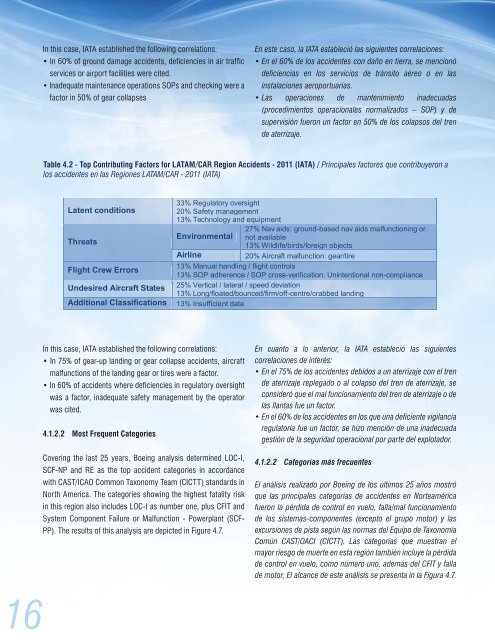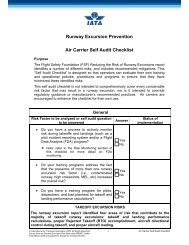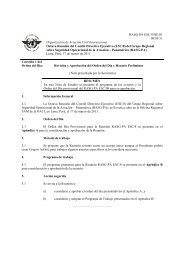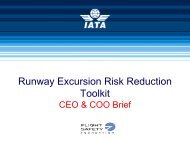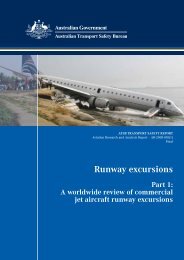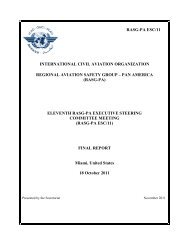Reporte Anual de Seguridad Operacional - aci-lac.aero
Reporte Anual de Seguridad Operacional - aci-lac.aero
Reporte Anual de Seguridad Operacional - aci-lac.aero
You also want an ePaper? Increase the reach of your titles
YUMPU automatically turns print PDFs into web optimized ePapers that Google loves.
In this case, IATA established the following correlations:<br />
• In 60% of ground damage acci<strong>de</strong>nts, <strong>de</strong>ficiencies in air traffic<br />
services or airport f<strong>aci</strong>lities were cited.<br />
• Ina<strong>de</strong>quate maintenance operations SOPs and checking were a<br />
factor in 50% of gear collapses<br />
En este caso, la IATA estableció las siguientes correl<strong>aci</strong>ones:<br />
• En el 60% <strong>de</strong> los acci<strong>de</strong>ntes con daño en tierra, se mencionó<br />
<strong>de</strong>ficiencias en los servicios <strong>de</strong> tránsito aéreo o en las<br />
instal<strong>aci</strong>ones <strong>aero</strong>portuarias.<br />
• Las oper<strong>aci</strong>ones <strong>de</strong> mantenimiento ina<strong>de</strong>cuadas<br />
(procedimientos oper<strong>aci</strong>onales normalizados – SOP) y <strong>de</strong><br />
supervisión fueron un factor en 50% <strong>de</strong> los colapsos <strong>de</strong>l tren<br />
<strong>de</strong> aterrizaje.<br />
Table 4.2 - Top Contributing Factors for LATAM/CAR Region Acci<strong>de</strong>nts - 2011 (IATA) / Principales factores que contribuyeron a<br />
los acci<strong>de</strong>ntes en las Regiones LATAM/CAR - 2011 (IATA)<br />
Latent conditions<br />
Threats<br />
Flight Crew Errors<br />
Un<strong>de</strong>sired Aircraft States<br />
Additional Classifications<br />
33% Regulatory oversight<br />
20% Safety management<br />
13% Technology and equipment<br />
27% Nav aids: ground-based nav aids malfunctioning or<br />
Environmental not available<br />
13% Wildlife/birds/foreign objects<br />
Airline<br />
20% Aircraft malfunction: gear/tire<br />
13% Manual handling / flight controls<br />
13% SOP adherence / SOP cross-verification: Unintentional non-compliance<br />
25% Vertical / lateral / speed <strong>de</strong>viation<br />
13% Long/floated/bounced/firm/off-centre/crabbed landing<br />
13% Insufficient data<br />
In this case, IATA established the following correlations:<br />
• In 75% of gear-up landing or gear collapse acci<strong>de</strong>nts, aircraft<br />
malfunctions of the landing gear or tires were a factor.<br />
• In 60% of acci<strong>de</strong>nts where <strong>de</strong>ficiencies in regulatory oversight<br />
was a factor, ina<strong>de</strong>quate safety management by the operator<br />
was cited.<br />
4.1.2.2 Most Frequent Categories<br />
Covering the last 25 years, Boeing analysis <strong>de</strong>termined LOC-I,<br />
SCF-NP and RE as the top acci<strong>de</strong>nt categories in accordance<br />
with CAST/ICAO Common Taxonomy Team (CICTT) standards in<br />
North America. The categories showing the highest fatality risk<br />
in this region also inclu<strong>de</strong>s LOC-I as number one, plus CFIT and<br />
System Component Failure or Malfunction - Powerplant (SCF-<br />
PP). The results of this analysis are <strong>de</strong>picted in Figure 4.7.<br />
En cuanto a lo anterior, la IATA estableció las siguientes<br />
correl<strong>aci</strong>ones <strong>de</strong> interés:<br />
• En el 75% <strong>de</strong> los acci<strong>de</strong>ntes <strong>de</strong>bidos a un aterrizaje con el tren<br />
<strong>de</strong> aterrizaje replegado o al colapso <strong>de</strong>l tren <strong>de</strong> aterrizaje, se<br />
consi<strong>de</strong>ró que el mal funcionamiento <strong>de</strong>l tren <strong>de</strong> aterrizaje o <strong>de</strong><br />
las llantas fue un factor.<br />
• En el 60% <strong>de</strong> los acci<strong>de</strong>ntes en los que una <strong>de</strong>ficiente vigilancia<br />
regulatoria fue un factor, se hizo mención <strong>de</strong> una ina<strong>de</strong>cuada<br />
gestión <strong>de</strong> la seguridad oper<strong>aci</strong>onal por parte <strong>de</strong>l explotador.<br />
4.1.2.2 Categorías más frecuentes<br />
El análisis realizado por Boeing <strong>de</strong> los últimos 25 años mostró<br />
que las principales categorías <strong>de</strong> acci<strong>de</strong>ntes en Norteamérica<br />
fueron la pérdida <strong>de</strong> control en vuelo, falla/mal funcionamiento<br />
<strong>de</strong> los sistemas-componentes (excepto el grupo motor) y las<br />
excursiones <strong>de</strong> pista según las normas <strong>de</strong>l Equipo <strong>de</strong> Taxonomía<br />
Común CAST/OACI (CICTT). Las categorías que muestran el<br />
mayor riesgo <strong>de</strong> muerte en esta región también incluye la pérdida<br />
<strong>de</strong> control en vuelo, como número uno, a<strong>de</strong>más <strong>de</strong>l CFIT y falla<br />
<strong>de</strong> motor, El alcance <strong>de</strong> este análisis se presenta in la Figura 4.7.<br />
16


